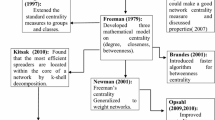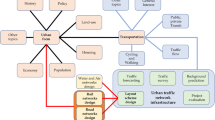Abstract
Influence spread is one of the key problems in complex networks, and the results of influence maximization problem (IMP) based on dynamic networks are less. In this paper, we discuss the dynamic IMP and describe the dynamic independent cascade model (DICM) and the dynamic linear threshold model (DLTM). We also conclude that IMP based on DICM and DLTM is NP-Hard. To solve the IMP, we present an improved greedy algorithm that is validated based on four datasets with different sizes. Our findings indicate that, compared with the HT algorithm, the size of the influence spread of our algorithm has an obvious advantage, and time efficiency is better than that of the HT algorithm.




Similar content being viewed by others
References
Chen W, Wang C, Wang Y (2010) Scalable influence maximization for prevalent viral marketing in large scale social networks. In: The 16th ACM SIGKDD Conference on Knowledge Discovery and Data Mining (KDD), Washington, pp 1029–1038
Chen W, Wang Y, Yang S (2009) Efficient influence maximization in social networks. In: The 15th ACM SIGKDD Conference on Knowledge Discovery and Data Mining (KDD), Paris, pp 199–207
Chen W, Yuan Y, Zhang L (2010) Scalable influence maximization in social networks under the linear threshold model. In: The 2010 IEEE International Conference on Data Mining (ICDM), Sydney, pp 88–97
Domingos P, Richardson M (2001) Mining the network value of customers. In: The 7th ACM SIGKDD International Conference on Knowledge Discovery and Data Mining (KDD), San Francisco, pp 57–66
Domingos P, Richardson M (2002) Mining knowledge-sharing sites for viral marketing. In: The 8th ACM SIGKDD International Conference on Knowledge Discovery and Data Mining (KDD), Edmonton, pp 61–70
Even-Dar E, Shapira A (2007) A note on maximizing the spread of influence in social networks. WINE 2007, LNCS 4858, pp 281–286
Fu C, Zhang P, Jiang J et al (2015) A Bayesian Approach for Sleep and Wake Classification based on Dynamic Time Warping Method. Multimedia Tools and Applications
Goldenberg J, Libai B, Muller E (2001) Talk of the network: A complex systems look at the underlying process of word-of-mouth. Mark Lett 12(3):211–223
Granovetter M (1978) Threshold models of collective behavior. Am J Sociol 83 (6):1420–1443
Gu W, Lv Z, Hao M (2015) Change detection method for remote sensing images based on an improved Markov random field[J]. Multimedia Tools and Applications:1–16
Habiba TB-W (2007) Maximizing the extent of spread in a dynamic network. Technical Report 20, DIMACS
Habiba Yu Y, Berger-Wolf T Y, Saia J (2008) Finding spread blockers in dynamic networks. The 2nd SNA-KDD Workshop, LasVegas
Jiang D, Xu Z, Li W et al (2015) An Energy-Ecient Multicast Algorithm with Maximum Network Throughput in Multi-hop Wireless Networks. Journal of Communications and Networks
Jiang D, Xu Z, Lv Z (2015) A multicast delivery approach with minimum energy consumption for wireless multi-hop networks[J]. Telecommunication Systems
Jiang D, Ying X, Han Y et al (2015) Collaborative multi-hop routing in cognitive wireless networks[J]. Wirel Pers Commun:1–23
Kempe D, Kleinberg J M, Tardos É (2003) Maximizing the spread of influence through a social network. In: The 9th ACM SIGKDD Conference on Knowledge Discovery and Data Mining (KDD), Washington, pp 137–146
Lahiri M, Cebrian M (2010) The genetic algorithm as a general diffusion model for social networks. In: The Twenty-Fourth AAAI Conference on Artificial Intelligence, Atlanta, pp 494–499
Leskovec J (2008) Dynamics of Large Networks. Carnegie Mellon University, Pittsburgh
Leskovec J, Krause A, Guestrin C, Faloutsos C, VanBriesen J, Glance NS (2007) Cost-effective outbreak detection in networks. In: The 13th ACM SIGKDD Conference on Knowledge Discovery and Data Mining (KDD), San Jose, pp 420–429
Li X, Lv Z, Zheng Z et al (2015) Assessment of lively street network based on Geographic information system and Space Syntax[J]. Multimedia Tools and Applications
Lin Y, Yang J, Lv Z et al (2015) A Self-Assessment Stereo Capture Model Applicable to the Internet of Things[J]. Sensors 15(8):20925–20944
Lv Z, Halawani A, Feng S, et al. (2014) Multimodal hand and foot gesture interaction for handheld devices. ACM Transactions on Multimedia Computing, Communications, and Applications (TOMM) 11(1s):10
Lv Z, Yin T, Han Y, et al. (2011) WebVRweb virtual reality engine based on P2P network[J]. J Netw 6(7):990–998
Nemhauser G, Wolsey L, Fisher M (1978) An analysis of the approximations for maximizing submodular set functions. Math Program 14(1):265–294
Wang K, Zhou X, Li T et al (2014) Optimizing load balancing and data-locality with data-aware scheduling. In: 2014 IEEE International Conference on Big Data (Big Data). IEEE, pp 119–128
Acknowledgments
This work is supported by National Social Science Foundation of China (No. 11BF- X125), PuJiang Talent Project, Peak of law subject construction and Public Security Discipline Construction Foundation.
Author information
Authors and Affiliations
Corresponding author
Rights and permissions
About this article
Cite this article
Wang, XG. A new algorithm for the influence maximization problem in dynamic networks or traffic sensor networks. Multimed Tools Appl 75, 4833–4844 (2016). https://doi.org/10.1007/s11042-016-3266-9
Received:
Revised:
Accepted:
Published:
Issue Date:
DOI: https://doi.org/10.1007/s11042-016-3266-9




